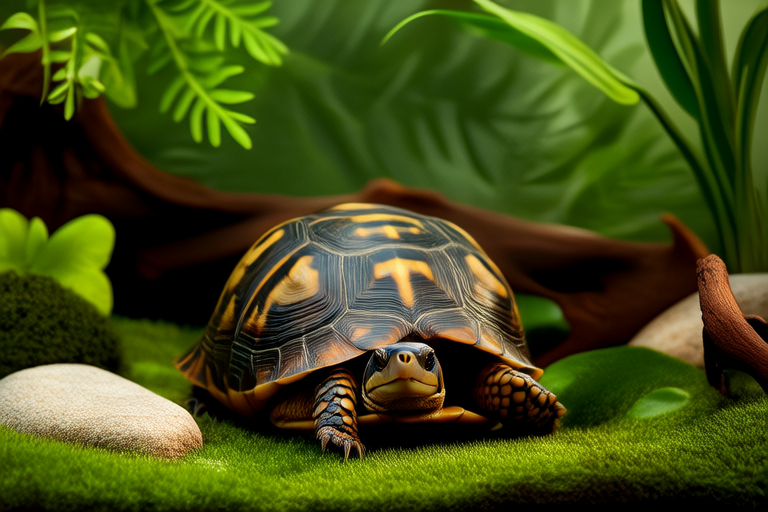Terrific Terrariums: Setting Up the Perfect Home for a Three-Striped Box Turtle
Welcome to the world of three-striped box turtles! These fascinating reptiles are native to parts of Asia and make wonderful pets for those who are ready for the responsibility. In this guide, we will walk you through setting up the perfect terrarium for your three-striped box turtle, ensuring they live a healthy and happy life. We’ll cover everything from terrarium size and lighting requirements to substrate options, hiding spots, and more.
Choosing the Right Terrarium Size
The first step in creating the perfect home for your three-striped box turtle is selecting an appropriately sized terrarium. A general rule of thumb is to provide at least five square feet of space per turtle. This ensures that they have enough room to move around comfortably and engage in natural behaviors like burrowing and basking. For a single adult turtle, a terrarium measuring approximately 48 inches by 24 inches is recommended. If you plan to keep multiple turtles together, increase the size accordingly.
Lighting Requirements
Proper lighting is crucial for the well-being of your three-striped box turtle. They require both UVB light for vitamin D synthesis and heat lamps to maintain their body temperature. Invest in high-quality UVB bulbs designed specifically for reptiles, and position them so that they cover at least half of the terrarium’s surface area. Replace these bulbs every six months to ensure optimal performance. Additionally, install a basking lamp on one end of the terrarium to create a temperature gradient. The basking spot should reach between 90°F and 95°F (32°C to 35°C), while the cooler side can range from 75°F to 85°F (24°C to 29°C).
Temperature Control
Maintaining consistent temperatures within the terrarium is vital for your turtle’s health. Use a thermostat or rheostat to regulate the heat output of your basking lamp, preventing overheating. Place a digital thermometer with separate probes inside the enclosure to monitor both the warm and cool zones accurately. Nighttime temperatures can drop slightly but should never fall below 65°F (18°C). Consider adding a ceramic heat emitter or under-tank heater if necessary to maintain warmth during colder periods.
Substrate Options
Selecting the right substrate is important for replicating your turtle’s natural environment and promoting good hygiene. Avoid using gravel, sand, or cedar shavings as they pose choking hazards and may cause impaction. Instead, opt for eco-friendly substrates like coconut fiber bedding, cypress mulch, or orchid bark. These materials help retain moisture while allowing drainage, mimicking the humid conditions found in their native habitats. Ensure that the substrate remains clean and dry, replacing it regularly to prevent bacterial growth.
Hiding Spots and Decorations
Your three-striped box turtle needs places where it can retreat and feel secure. Provide plenty of hiding spots using artificial caves, half logs, or overturned plant pots. Arrange these items strategically throughout the terrarium to encourage exploration and reduce stress. Incorporate live or artificial plants to add visual interest and create additional hiding spaces. Choose species that are non-toxic and safe for reptiles, such as pothos or spider plants. Remember to place objects securely to prevent tipping or collapsing.
Water Area
A shallow water dish large enough for your turtle to soak in provides hydration and aids in thermoregulation. Position the dish on the cooler side of the terrarium and refill it daily with fresh, dechlorinated water. Monitor the water level closely, especially if your turtle tends to tip over the dish accidentally. You might consider investing in a small aquarium pump to maintain circulation and oxygenation, although this isn’t always necessary.
Diet Specifics
Feeding your three-striped box turtle a balanced diet is essential for maintaining its health. Their diet should consist primarily of vegetables, fruits, and protein sources. Offer leafy greens like collard greens, dandelion leaves, and romaine lettuce as staples. Supplement these with occasional treats such as berries, melons, and chopped apples. Protein can come from insects like crickets, mealworms, and earthworms. Feed your turtle several times a week, adjusting portions based on age and activity levels. Always gut-load feeder insects with nutritious foods before offering them to your pet.
Health Care Tips
Regular veterinary check-ups are key to keeping your three-striped box turtle healthy. Schedule annual examinations with a reptile specialist who understands the unique needs of these animals. Keep an eye out for signs of illness, such as lethargy, loss of appetite, swollen eyes, or abnormal stools. Address any concerns promptly by consulting your veterinarian. Maintaining proper hygiene practices also plays a significant role in preventing diseases. Clean the terrarium thoroughly once a week, removing waste and disinfecting surfaces as needed.
Common Mistakes to Avoid
When caring for three-striped box turtles, there are several common pitfalls to watch out for:
- Overfeeding: Be cautious not to exceed recommended portion sizes, which can lead to obesity and other health issues.
- Inadequate Lighting: Failing to provide sufficient UVB exposure can result in metabolic bone disease.
- Poor Hygiene: Neglecting regular cleaning schedules allows bacteria and parasites to thrive.
- Lack of Environmental Enrichment: Providing limited opportunities for stimulation may cause behavioral problems.
By avoiding these mistakes and following our comprehensive guide, you’ll be well on your way to becoming a successful three-striped box turtle owner. Remember that each turtle has individual preferences, so pay close attention to your pet’s behavior and adjust its habitat accordingly.
We hope this guide has provided you with valuable insights into setting up the perfect terrarium for your three-striped box turtle. With dedication and care, you can ensure that your new friend enjoys a long and healthy life. Happy turtle keeping!
